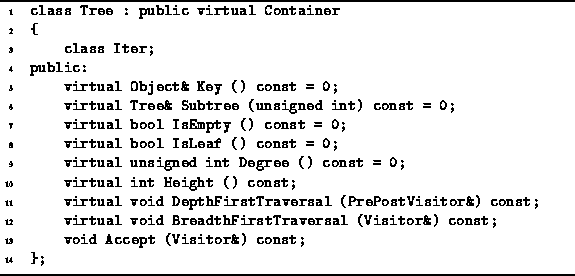 Data Structures and Algorithms
with Object-Oriented Design Patterns in C++
Data Structures and Algorithms
with Object-Oriented Design Patterns in C++





In this section we consider the implementation of trees
including general trees, N-ary trees, and binary trees.
The implementations presented have been developed in the context
of the abstract data type framework presented in Chapter  .
I.e., the various types of trees are viewed
as classes of containers
as shown in Figure
.
I.e., the various types of trees are viewed
as classes of containers
as shown in Figure  .
.

Figure: Object Class Hierarchy
Program  declares the Tree abstract class.
The Tree class encapsulates those interface elements
which are common to all of the tree implementations presented in this chapter.
The Tree class combines the tree interface
with the container interface given in Section
declares the Tree abstract class.
The Tree class encapsulates those interface elements
which are common to all of the tree implementations presented in this chapter.
The Tree class combines the tree interface
with the container interface given in Section  .
.

Program: Tree Class Definition
The Tree class adds the following functions
to the public interface inherited from the Container base class:
- Key
-
This accessor returns a reference to the object
contained in the root node of a tree.
- Subtree
-
This accessor returns a reference to the
 subtree
of the given tree.
subtree
of the given tree.
- IsEmpty
-
This function is a Boolean-valued accessor which
returns true if the root of the tree is an empty tree,
i.e., an external node.
- IsLeaf
-
This function is a Boolean-valued accessor which
returns true if the root of the tree
is a leaf node.
- Degree
-
This accessor returns the degree of the root node of the tree.
The result is an unsigned int.
By definition, the degree of an external node is zero.
- Height
-
This accessor returns the height of the tree.
The result is a (signed) int.
By definition, the height of an empty tree is -1.
- DepthFirstTraversal and BreadthFirstTraversal
-
These functions are analogous to the Accept member
function of the container class (see Section
 ).
Both of these functions perform a traversal.
I.e., all the nodes of the tree are visited systematically.
The former takes a reference to a PrePostVisitor
and the latter takes a reference to a Visitor.
When a node is visited,
the appropriate functions of the visitor are applied to that node.
).
Both of these functions perform a traversal.
I.e., all the nodes of the tree are visited systematically.
The former takes a reference to a PrePostVisitor
and the latter takes a reference to a Visitor.
When a node is visited,
the appropriate functions of the visitor are applied to that node.
The preceding member functions of the Tree class
are all pure virtual functions.
Therefore,
the Tree class is an abstract base class from which
specific concrete tree classes are derived.





 Copyright © 1997 by Bruno R. Preiss, P.Eng. All rights reserved.
Copyright © 1997 by Bruno R. Preiss, P.Eng. All rights reserved.
![]() .
I.e., the various types of trees are viewed
as classes of containers
as shown in Figure
.
I.e., the various types of trees are viewed
as classes of containers
as shown in Figure ![]() .
.

![]() declares the Tree abstract class.
The Tree class encapsulates those interface elements
which are common to all of the tree implementations presented in this chapter.
The Tree class combines the tree interface
with the container interface given in Section
declares the Tree abstract class.
The Tree class encapsulates those interface elements
which are common to all of the tree implementations presented in this chapter.
The Tree class combines the tree interface
with the container interface given in Section ![]() .
.
